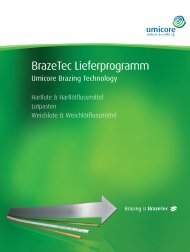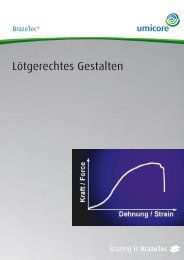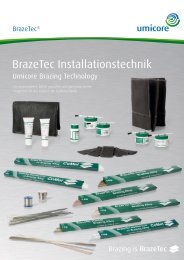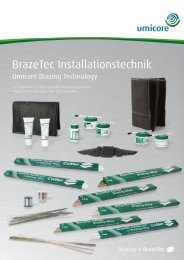Principles of brazing technology - technicalmaterials.umicore.com
Principles of brazing technology - technicalmaterials.umicore.com
Principles of brazing technology - technicalmaterials.umicore.com
You also want an ePaper? Increase the reach of your titles
YUMPU automatically turns print PDFs into web optimized ePapers that Google loves.
<strong>Principles</strong> <strong>of</strong> <strong>brazing</strong> <strong>technology</strong><br />
Start <strong>of</strong> the wetting Intermediate state<br />
II = Workpiece 1<br />
II = Workpiece 2<br />
Both bare metal, and<br />
heated to working<br />
temperature<br />
• Liquid <strong>brazing</strong> alloy<br />
Capillary filling pressure<br />
Final state<br />
The <strong>brazing</strong> alloy is pressed into the gap by capillary<br />
forces. The narrower the <strong>brazing</strong> gap, the higher the<br />
capillary filling pressure.<br />
For a 0.1 mm parallel gap, the capillary filling<br />
pressure reaches ca. 100 mbar, corresponding to<br />
about 0.1 Atm. This in turn corresponds to about a 1<br />
m column <strong>of</strong> water ( ρ = 1); assuming ρ = 10 g/cm 3<br />
(the density <strong>of</strong> a <strong>brazing</strong> alloy), the capillary height<br />
for low melting point <strong>brazing</strong> alloys in a 0.1 mm wide<br />
gap can be calculated to be ca. 10 cm. This agrees<br />
reasonably well with experiences in practice.<br />
Gap too narrow<br />
Correct gap width<br />
(only applies for<br />
<strong>brazing</strong> with flux)<br />
Permissible gap width for manual <strong>brazing</strong><br />
Gap too wide<br />
Different gap cross-sections give different filling<br />
pressures. An open fillet has a six times higher<br />
capillary filling pressure than a parallel flat gap.<br />
3. Brazing alloy and flux groups<br />
3.1 Brazing alloys<br />
According to DIN 8505, alloys with a liquidus<br />
temperature below 450°C are solders and those with<br />
a liquidus temperature above 450°C are <strong>brazing</strong><br />
alloys.<br />
The upper and lower <strong>brazing</strong> temperature limits are<br />
determined by the following:<br />
lower limit<br />
- the working temperature<br />
upper limit<br />
- the flux (be<strong>com</strong>es saturated with oxides at<br />
too high temperatures), or<br />
- the <strong>brazing</strong> alloy (individual <strong>com</strong>ponents <strong>of</strong><br />
the alloy can evaporate), or<br />
- the economics <strong>of</strong> the process (unnecessarily<br />
high temperatures cost unnecessary time<br />
and energy), or<br />
- the base material (structural transformation;<br />
strength loss).<br />
Umicore AG & Co. KG - BrazeTec, Rodenbacher Chaussee 4, D-63457 Hanau-Wolfgang<br />
Telefon: +49 (0) 6181-59-03 Telefax: +49 (0) 6181-59-3107 Email: info@BrazeTec.de Internet: www.BrazeTec.de








